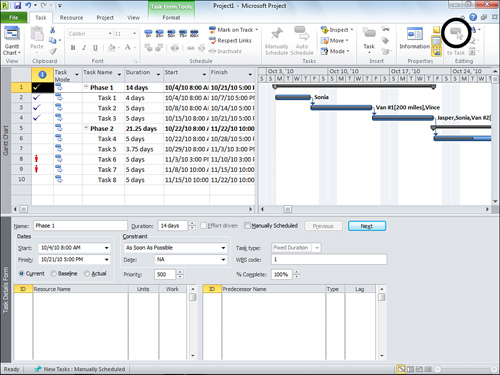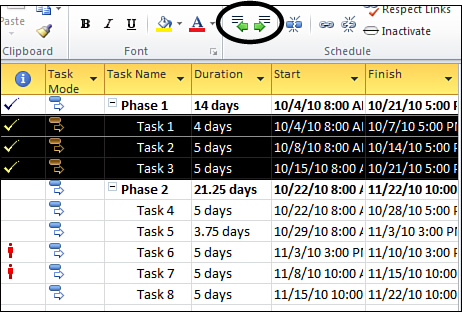Understanding Task Types
Each task in your project can be one of three different types:
Fixed units
Fixed work
Fixed duration
These task types are used to
determine which element of a task is most important for scheduling, so
that Project knows what it should maintain as it sets your project’s
schedule. Project calculates the schedule using the following formula: Duration = Work / Units.
Table 1 shows what changes Project makes, based on task types, for a task that is set to automatic scheduling.
Table 1. Task Types
| Task Type | Adjust Units | Adjust Work | Adjust Duration |
|---|
| Fixed units | Duration is adjusted. | Duration is adjusted. | Work is adjusted. |
| Fixed work | Duration is adjusted. | Duration is adjusted. | Units are adjusted. |
| Fixed duration | Work is adjusted. | Units are adjusted. | Work is adjusted. |
Fixed Units
Fixed units
is the task type to pick if the level of effort on your project is
important to you. For example, let’s say you assign a resource to a
task, and you know you can only use that resource for that task half
time. You assign the resource at 50% (units). After your initial
planning, you find out that you need to make the task longer, or you
discover that the task may take more work than you thought. You don’t
want Project to change the units, so you choose the fixed units task
type. This leaves the resource assigned at 50%, and Project recalculates
the work or duration, based on what factor you changed.
Looking at this from a formula
perspective, say the original duration of the task is 5 days, the work
is initially set to 20 hours, and the units is set to 50%. The formula
would look like this: 5d = 20h / 50%. If the task is fixed units, you
can’t change the 50%.
Changed duration—
If the duration is increased to 10 days, Project will adjust the 20
hours of work to maintain a balanced equation: 10d = 40h / 50%. Because
the task is set to fixed units, the resource will always work at 50%. So
if you increase the duration, the resource will work more hours.
Project will increase the work to 40 hours.
Changed work—
If the work is increased to 40 hours, Project will adjust the 5 days of
duration, because the resource is only able to work at 50%, or 20 hours
per week. It will take the resource 10 days to get 40 hours of work
done, working 20 hours per week. This adjustment maintains a balanced
equation: 10d = 40h / 50%.
Fixed Work
If a task is set to fixed work, Project will maintain the amount of work scheduled for the task. Look again at the previous example: 5d = 20h / 50%.
Changed units—
If you need to keep the task set to 20 hours of work, and you find out
that your resource is only available at 25% instead of 50%, Project will
adjust the duration to 10 days because it will take the resource longer
to get the work done if he or she is working fewer hours each week.
This maintains a balanced equation: 10d = 20h / 25%.
Changed duration—
If you find out that you have 10 days to get the task done, instead of
5, Project will adjust the units to 25%, because it will take less of
the resource’s time each week to get the work done. This maintains a
balanced equation: 10d = 20h / 25%.
Fixed Duration
If a task is set to fixed
duration, Project will maintain the length of time you’ve set aside to
complete the task. Again, return to the example: 5d = 20h / 50%.
Changed work—
If the amount of work increases to 40 hours, with the duration fixed at
5 days, Project will adjust the resource units. Instead of 50%, the
task now requires 100% to get 40 hours of work done in 5 days. The
balanced equation is: 5d = 40h / 100%. You can get to 100% by increasing
the amount of time the existing resource works in a week, or by
assigning additional resources to the task.
Changed units—
If you find out that the resource assigned to the task is now available
at 100% of his or her time, Project will adjust the amount of work for
the task, to maintain the 5 days of duration: 5d = 40h / 100%. Because
the resource is assigned at 100%, he or she can fit in 40 hours of work
in 5 days, instead of 20 hours.
Adding Tasks to Your Project
When adding tasks to your
project in Project 2010, you can choose to fill out a lot of detail
about your tasks upfront, or you can enter some basic scheduling
information at first and then fill in more details later.
Adding a New Task
To add a new task to your project, follow these steps:
1. | In the Gantt Chart view, type a name for the new task in the first empty row of the Task Name column.
|
To insert a new task between two existing tasks, right-click a task row and click Insert Task to add a new row above.
|
|
2. | Click the Task Mode column and then choose whether you want the task to be Manually Scheduled or Auto Scheduled.
Project uses one of these methods as a default. You only need to choose
a method if you don’t want to use what is set as the default.
|
3. | Type the number of days over which you want the task work completed in the Duration
column. You also can use minutes (m), hours (h), weeks (w), or months
(mo) if one of these would be more appropriate for your project.
|
4. | Set the task’s Start and Finish dates:
If you selected Auto Scheduled in step 2, the Start and Finish
columns will be populated automatically with the appropriate dates,
based on the project scheduling options you chose when you created the
project . Do not manually set a start or finish date if you are using automatic scheduling. If you selected Manually Scheduled in step 2, choose a Start date, and Project will fill in a Finish date. Alternatively, choose a Finish date, and Project will fill in a Start date. Project calculates the Start or Finish date using the information you entered in the Duration column.
|
5. | To set additional task details, go to the Task tab of the ribbon. In the Properties group, click Details to display the Task Details Form view split with the Gantt Chart view, as shown in Figure 1.

|
6. | Use the Task Details Form view to set the following:
- Task type— Choose whether the task is Fixed Duration, Fixed Units, or Fixed Work.
- Constraint— By default, this field is set to As Soon As Possible, meaning that the task could happen at any appropriate time in the project. You also can choose As Late As Possible,
if that makes more sense for your project. However, you may have some
tasks that need to happen in coordination with a specific date. You can
choose from the following constraints: Finish No Earlier Than, Finish No Later Than, Must Finish On, Must Start On, Start No Earlier Than, and Start No Later Than. If you choose one of these constraints, be sure to choose an associated date using the Date box within the Constraint box.
|
When choosing a constraint for a
task, keep in mind that what you choose can impact Project’s ability to
do things like enforce links to other tasks and properly distribute
resource work on the task.
|
|
7. | Click OK to save your task settings.
|
Setting a Task Calendar
Sometimes,
a task in your project may need to use a different schedule from the
rest of your project. For example, let’s say a specific task needs to
happen over a weekend. The overall project calendar has the weekends set
as nonworking days. You can set a separate calendar for that task, so
that the weekend days are set as working days. Other tasks in your
project will still see the weekend as nonworking days, but the task with
the modified task calendar will see the weekend as working days.
Follow these steps to set a separate calendar for a task:
1. | On the Project tab of the ribbon, in the Properties group, click Change Working Time.
|
2. | Click Create New Calendar.
|
3. | Choose how you want to create the task’s calendar:
- Create new base calendar— Click this to create a new calendar for your task, from scratch. Working times will be set to the calendar options from the Project Options dialog box, by default.
- Make a copy of [existing base] calendar—
Click this to use an existing base calendar as a starting point for
your task’s calendar. Use the drop-down list to choose which base
calendar you want to copy.
|
4. | Type a name for your task’s calendar in the Name
box. You may want to use a name that helps to identify this as a
calendar that is intended for use on a specific task. This will help to
differentiate it from the base calendars for your project.
|
5. | Click OK to create your task’s calendar.
|
6. | Similar
to creating a base calendar, set the working days, nonworking days,
default working times, and working times for specific time periods in
your task’s calendar.
|
7. | With your task’s calendar set up and saved, double-click the task row in the Gantt Chart view.
|
8. | Click the Advanced tab and then choose the calendar you just created from the Calendar list.
|
9. | Click OK to save the calendar setting.
|
Indenting and Outdenting Tasks
After
you have a list of tasks added to your project, you may find that you
want to add some organizational structure to your tasks. You can indent
and outdent tasks to add hierarchy to your project. Tasks that have
other tasks indented below them are called summary tasks. Tasks that are indented below another task are called subtasks.
Summary tasks roll up data from their subtasks. For example, if a
summary task has two subtasks, the summary task will take the earliest
start date and the latest finish date from those subtasks, as shown in Figure 2.

To indent or outdent a task, click the task in the Gantt Chart view to select it. Then, on the Task tab of the ribbon, in the Schedule group, click Indent or Outdent, as shown in Figure 3.

You can also choose to display the project summary task, which will roll
all tasks and summary tasks up to the very top level of the project. To
display the project summary task, click the File tab on the ribbon, click Options, and then click Advanced. Under Display options for this project, select the Show project summary task check box and then click OK.